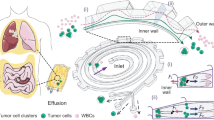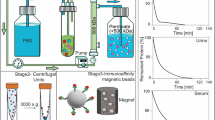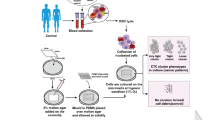Abstract
A simple method is described for the separation of cells derived from effusions of patients with adenocarcinomas in discontinuous density gradients of Percoll. After separation, cells from different fractions were analyzed by morphologic, histochemical and immunologic criteria. Total cell recovery from 27 experiments was 67 +/- 4%. Macrophages (82%) were recovered in the intermediate density fraction (1.056-1.067 g ml-1) with a purity of 90%. Recovered lymphocytes (98%) were found in the high density fraction (1.067-1.077 g ml-1) with a purity of 92%. The majority of the lymphocytes recovered were T cells. Malignant adenocarcinoma cells (90%) were recovered in the lowest density fractions (up to 1.056 g ml-1) with a purity of 79%. Use of effective cell separation procedures should facilitate the analysis of the functional capacities of both normal and neoplastic cells derived from human malignant effusions.
This is a preview of subscription content, access via your institution
Access options
Subscribe to this journal
Receive 24 print issues and online access
$259.00 per year
only $10.79 per issue
Buy this article
- Purchase on Springer Link
- Instant access to full article PDF
Prices may be subject to local taxes which are calculated during checkout
Similar content being viewed by others
Rights and permissions
About this article
Cite this article
Hamburger, A., Dunn, F. & White, C. Percoll density gradient separation of cells from human malignant effusions. Br J Cancer 51, 253–258 (1985). https://doi.org/10.1038/bjc.1985.36
Issue Date:
DOI: https://doi.org/10.1038/bjc.1985.36



